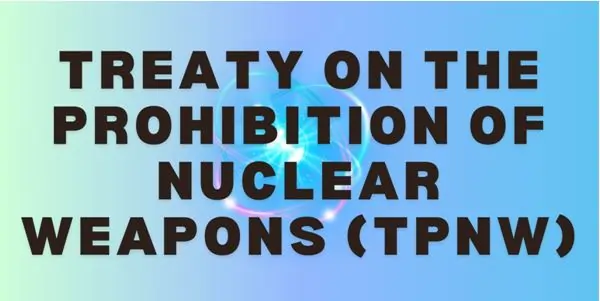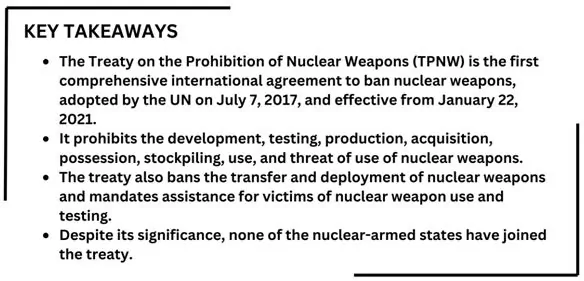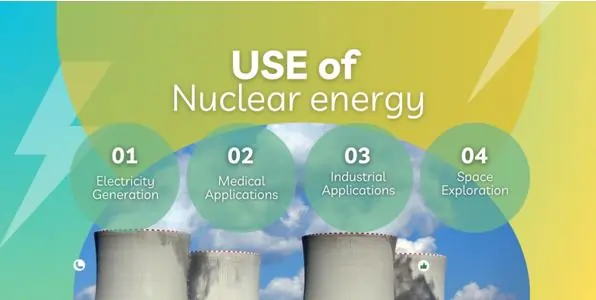
The Treaty on the Prohibition of Nuclear Weapons (TPNW), or Nuclear Weapon Ban Treaty, is a major breakthrough in international disarmament law. Agreed in 2017 at the United Nations and effective from 2021, the TPNW is the only treaty in international law that provides for an outright ban on nuclear weapons with the obvious aim of doing away with them.
Historical Context
Towards the formation of the TPNW, the journey began in post World War II, specific turning point to campaign against nuclear weapon was the bombings of Hiroshima and Nagasaki which caused huge humanitarian suffering. Over the existing decades, measures intended to prevent and minimize nuclear possession and capability were signed, including the Treaty on the Non-Proliferation of Nuclear Weapons in 1968. However the NPT has only partial prohibitions and which has not banned nuclear weapons in totality lead to the need for this stronger set up.In December 2016, the UN General Assembly passed a resolution to launch negotiations for the banning Nuclear weapons. These negotiations occurred in two parts in 2017, and the TPNW was favoured by a total of 122 and 1 against, and 1 abstention.
Key Provisions
The TPNW covers a wide range of prohibitions of activities concerning nuclear weapons. These include:
- Development, Testing, Production, and Acquisition: They cannot establish, use, produce, manufacture, procure or otherwise accumulate nuclear weapons or other nuclear explosive devices.
- Possession and Stockpiling: The treaty prohibits the basing, deployment, creation, or storage of nuclear weapons.
- Use and Threat of Use: The actual or threatened utilisation of nuclear weapons is absolutely prohibited.
- Transfer and Deployment: For a state party they cannot transfer or receive control over nuclear weapons, they also cannot allow the stationing, installation, or deployment of nuclear weapons on its territory.
- Assistance and Encouragement: The treaty also bans any provision of support, incentives or encouragement of actions banned in the TPNW.
Furthermore, there is victim ‘assistance’ as well as ‘environmental’ provisionin the TPNW due in consideration of the humanitarian effects of nuclear weapons use and testing.
Significance
The TPNW is significant for several reasons:
- Humanitarian Focus: The treaty is more inclined towards the humanitarian impact of nuclear weapons which is in context with humanitarian movement of disarmament. It accepts agonizing pains of the victims and the abused condition of the environment in view of the nuclear weapons.
- Stigmatization of Nuclear Weapons: Therefore the inclusion of a sweeping ban makes the TPNW’s purposes intended to delegitimize nuclear weapons and seek the global legal trend change towards the total eradication of nuclear weapons.
- Legal Framework: The TPNW fills the gap of the existing legal instruments including the NPT and nuclear-weapon-free zone treaties aimed at eliminating nuclear weapons.
- Catalyst for Disarmament: The treaty works as a disarmament initiative, it pushes the states to make real efforts in order to decrease and eventually eradicate their stockpile of nuclear weapons.
Challenges and Criticisms
Despite its significance, the TPNW faces several challenges and criticisms:
- Security Concerns: There is a precedent for this interpretation of the new Treaty – critics may claim that the TPNW does not properly address the security dilemmas of states that count on nuclear deterrence as a part of their security policies. They argue that a treaty destabilises the existing security framework and agreements in the globe.
- Verification and Compliance: Compliance with the provisions of the TPNW is very challenging especially given that verification is not well developed. However, the critics have pointed out that the treaty is ill-developed, regarding the mechanisms of verification and enforcement.
- Integration with Existing Frameworks: The main problem is the interaction of the TPNW with other existing disarmament arrangements, for example, the NPT. While some of the states regard the TPNW as consistent with the NPT, other considers it may be inconsistent with the NPT.
Conclusion
TPNW is a major achievement towards the goal of eliminating nuclear weapons from the face of the earth. As setting up a broad ban on nuclear weapon related activities, the TPNW seeks to isolate and consequently eradicate nuclear weapons as WMDs. Despite these challenges - no engagement of Nuclear Weapon States and problems related to the practical modalities of verification and confirmative measures, the APM treaty can be viewed as a step towards humanitarian and legal elimination of nuclear weapons with promises for further development of future multilateral disarmament regimes. Though the world is still facing the nuclear weapon threat, the TPNW symbolizes people’s unconquerable desire to live in the world free from nuclear threats.

Treaty on the Prohibition of Nuclear Weapons (TPNW) and India
The Treaty on the Prohibition of Nuclear Weapons commonly referred to as the Nuclear Weapon Ban Treaty remain one of the monumental compilations in disarmament on international law. The Treaty on the Prohibition of Nuclear Weapons was adopted by the United Nations in New York on July 7, 2017 and came into force on January 22, 2021 for the objective of complete and total elimination of nuclear weapons. Here an analysis of the TPNW history and India’s position in the context that will be helpful for understanding the outlined relations.
India’s Nuclear Policy & the TPNW
India has a similar nuclear portfolio, the nature of threat perception as well as the neighbourhood that India occupies makes its nuclear posture different from other nuclear powers. In may 1974 for the first time India conducted a nuclear test followed by a test in 1998 which confirmed its place in the nuclear states. Currently, India’s nuclear policy focuses on no first use, and minimum credible nuclear deterrent. New Delhi’s position stems from the opposition regarding the absence of credible containment of threats posed by the nuclear weapons capability, and flawed existing verification mechanism of the Preventive Partnership of Nuclear Weapons (TPNW). India has been arguing that nuclear disarmament should be gradual and done in phases, following guidelines of the NPT, which New Delhi considers more realistic and comprehensive.
India’s view on nuclear disarmament
India has adopted cautiously favourable attitude towards nuclear disarmament ownership. Nuclear disarmament policy of India reflects its commitment for non-proliferation and disarmament regime as well as its security concern. India has called for both universality and equal treatment of nuclear disarmament throughout non-membership times. It has endorsed the process towards the conclusion of a FMCT and urged for the start of the process of the NTC which prohibits the possession, production, testing, use and threat to use nuclear weapons.Looking at its interest India didn’t took part in the nuclear disarmament because of neighbours like China and Pakistan. India in particular has opined that there appears no clear mechanics towards disarmament in TPNW as it leaves behind most nuclear weapon states.
Nuclear Energy
Nuclear energy in the nucleus of atomic energy is a source of very important and highly energetic type of energy for man and they can be used for some good purposes and some bad purposes.
Understanding Nuclear Energy
Nuclear energy is produced through two primary processes: fission and fusion.
- Nuclear Fission: This process involves fission of the nucleus of a heavy atom like uranium 235 or plutonium 239 to formation of two or more small nuclei. This splitting also frees a lot of energy that can be used to perform many tasks.
- Nuclear Fusion: Fusion happens when two small nuclei of atomic number join to from a nucleus of a higher atomic number releasing energy. This is the same chemical interaction that catalyses the sun and is expected to define the future of energy.
Uses of Nuclear Energy
Nuclear is used for various purposes, from electricity generation, to propulsion, to military use etc.

- Electricity Generation: The best known application of nuclear power is probably the nuclear power station: here, nuclear fission takes place under controlled conditions to produce heat. The heat generated is used in creation of stream by boiling the water and that heat energy is used to rotate the turbines which ultimately turns the turbine and inside it the magnetic field is used to generate electricity.
- Medical Applications: Nuclear technology is in use in the medical field for imaging and for treating cancer.
- Industrial Applications: Nuclear energy is applied in production of food, testing materials, and the manufacture of isotopes for other uses within industries.
- Space Exploration: Nuclear energy has a potentialto be used in spacecraft’s and satellites to give them a renewable energy source for long-term missions.
Weaponisation of Nuclear Energy
Terrorist activity can be countered with the help of nuclear energy, which is embodied in the creation of nuclear weapons. These weapons use the very large amount of energy produced during the nuclear fission or nuclear fusion.
- Atomic Bombs (Fission Weapons): Hiroshima and Nagasaki type atomic bombs make use of nuclear fission only. In these weapons, a sufficient amount of fissile material [uranium 235 or plutonium 239] is assembled quickly and a chain reaction takes place releasing large volumes of energy.
- Hydrogen Bombs (Fusion Weapons): Hydrogen bombs, or thermonuclear weapons, derive their energy from nuclear fission reaction, though involve nuclear fusion. Such weapons mainly employ a fission bomb in detonating an implosion that generates the requisite heat and pressure for inducing fusion. The consequence of this process is orders of magnitude more efficient explosion than that in fission bombs.
Impacts of Nuclear Weapons
As it has already been discussed above the effects of nuclear weapon are not only extensive, but also severe.
- Immediate Destruction: Consequent on detonation of a nuclear weapon, the amount of energy released is astronomical destroying property and human life. The blast, heat and radiation can level down entire towns and populations of hundreds of thousands of people in a single moment.
- Radiation Exposure: People who become victims of a nuclear blast die from acute radiation sickness, suffer from chronic diseases, and are at a high risk of developing cancer.
- Environmental Damage: Nuclear explosions always exert a severe impact to the environment they pollute both the air, water as well as the soil. Those affected by a nuclear catastrophe cannot use the affected areas for years or even decades, respectively.
- Global Consequences: Nuclear explosions can cause the effects like nuclear winter that is when the temperatures drop dramatically due to effects of nuclear explosions like soot and debris preventing light from reaching the earth. It could often lead to crop losses throughout the regions and famine.